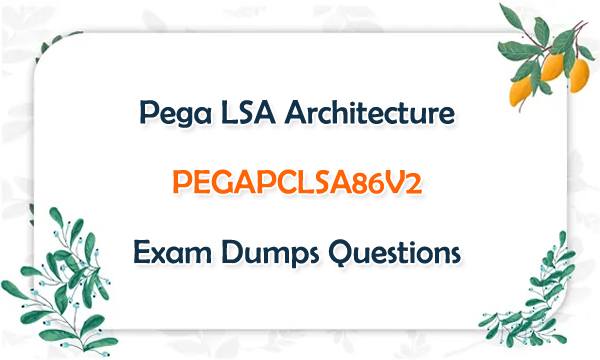Pega LSA Architecture PEGAPCLSA86V2 Exam Dumps Questions
September 01,2022 02:37 AM
PEGAPCLSA86V2 exam is the new one for Pega LSA Architecture certification, which is intended for Pega Certified Senior System Architects (PCSSAs) with at least 12+ months of field experience. The Pega LSA Architecture Version 8.6 exam focuses on design and architecture of Pega applications. PCLSA certification requires passing the Pega Architecture Exam and an Application design/build. Pega Senior Certified System Architect (P/CSSA) certification in any version is required to start the PCLSA certification program. Pega LSA Architecture PEGAPCLSA86V2 exam dumps questions are available for you to prepare for the test well.

PCLSA Certification PEGAPCLSA86V2 Exam
Lead System Architect (LSA) Pega Architecture Exam 86V2 PEGAPCLSA86V2 exam includes scenario questions, multiple choice questions and drag/drop items.
Type of Exam: 60-question exam, including scenario, multiple choice, and drag and drop questions
Length: 120 minutes
Passing Grade: 65%
Language: English
Pega LSA Architecture PEGAPCLSA86V2 Exam Topics
PEGAPCLSA86V2 Lead System Architect (LSA) Pega Architecture Exam 86V2 exam topics cover the following details.
Pega Platform Design (12%)
Application Design (13%)
Data Model Design (15%)
User Experience Design (7%)
Security Design (15%)
Reporting Design (12%)
Asynchronous Processing Design (8%)
Work Delegation Design (10%)
Deployment and Testing Design (8%)
Practice Pegasystems PEGAPCLSA86V2 Exam Dumps Questions
Pegasystems certification PEGAPCLSA86V2 exam dumps questions are the best material for you to study the above Lead System Architect (LSA) Pega Architecture Exam 86V2 exam topics. Share some Pega LSA Architecture PEGAPCLSA86V2 exam dumps questions and answers below.
1. How do you encrypt the storage stream of the class MyOrg-HR-Work-RFP?
A. Build a site-specific encrypting cypher and select Encrypt BLOB? on the class group for MyOrg-HRWork-RFP
B. Build a site-specific encrypting cypher and select Encrypt BLOB? on the class MyOrg-HR-Work-RFP
C. Select Encrypt BLOB? on the class MyOrg-HR-Work-RFP
D. Encrypt the pzPvStream colum of the DB table mapped to MyOrg-HR-Work-RFP class using DB tools
Answer: B
2. XYZ corp expects managers to create a variety of reports. Those reports are always based on the same set of classes, but every report does not use every class in the set. to simplify report creation for managers, you create
A. numerous sample reports showing how to join the classes
B. association rules for the classes in this set
C. a template report with every class join predefined
D. a declare trigger that restricts report class joins to this set
Answer: B
3. A case displays recent customer transaction. Different operators often view the recent transactions for the same customer repeatedly throughout the day. the operation to fetch the transactions is resource-intensive, and the source data is updated once an hour. select two options to configure a data page to cache the customer transactions and minimize the operator's wait time. (choose two)
A. configure the data page scope to node.
B. configure the refresh strategy to reload of older than 1 hour
C. configure the data page scope to thread.
D. configure the refresh strategy to reload once per interaction.
Answer: A B
4. You isolated the problem to node 1 of the cluster. You see node 1 goes down shortly after 3:00 p.m. every day with an out-of-memory error. Which two alerts typically precede this condition? (choose two)
A. PEGA0004 –Quantity of data received by database query exceeds limit
B. PEGA0001 – HTTP interaction time exceeds limit
C. PEGA00017 – Cache exceeds limit
D. PEGA0002 – Connect operation time exceeds limit
Answer: A D
5. Customer information is captured in an application. Corporate policy states that private information be secured and only visible to a limited users. Which configuration do you recommend?
A. Use a visible when rule for the properties displaying sensitive information.
B. Create an access control policy restricting access to the sensitive information.
C. Configure an access deny rule restricting access to the sensitive information.
D. Move sensitive information to separate sections and apply a privilege to the sections.
Answer: B
PEGAPCLSA86V2 Exam Dumps PDF & SOFT | 1 Year Free Update | Money Back Guarantee
- Related Suggestion
- New PEGACPLSA23V1 Dumps Help You Pass Pega Lead System Architecture Exam September 09,2024
- How to Prepare for PEGACPLSA88V1 Pega Lead System Architecture Exam? January 03,2024
- PEGAPCLSA86V1 Pega Architecture Version 8.6 Dumps Questions November 30,2021
- Pega Certified Lead System Architect PEGAPCLSA80V1_2020 Exam Dumps January 14,2021
- Certified Pega System Architect PEGACPSA23V1 Exam Dumps Online April 12,2024

